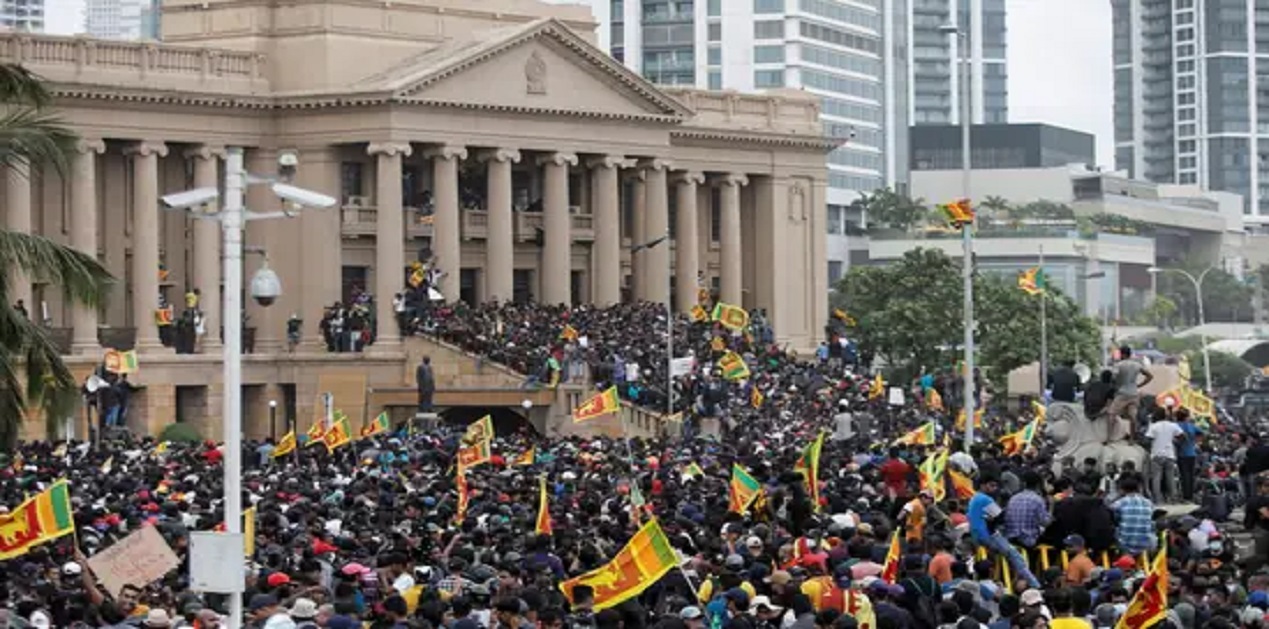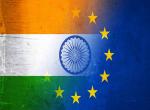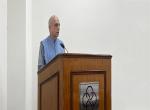Unfolding Events
Sri Lanka has elected six-time former Prime Minister Ranil Wickremesinghe as the new President. In the parliamentary votes Ranil Wickremesinghe received 134 votes against his closest contestant Dullus Alahapperuma got 82 votes. The contest was unique as the Parliament went to elect a new president sans any Rajapaksas in the race after a long time. The Rajapaksas, once invincible, have witnessed their downfall sooner than expected. President Gotabaya Rajapaksa first escaped to Maldives and then to Singapore and resigned through an emailamidst public protest crossing 100 days mark. The Army has reportedly been told to use lethal force in tackling the protestors and safeguarding public property[1] after the Presidential Palace and Office of the House Speaker were ransacked by the protestors. The 31st March protests against President Gotabaya and Prime Minister Mahinda had seen brutal police actions. Then onwards, the island nation has gone through several political phases including the appointment of opposition leader Ranil Wickremesinghe as Prime Minister who also served as acting President after Gotabaya Rajapaksa escaped to Singapore. Now, a State of Emergency has been declared in Sri Lanka. Interestingly, the global media has equated the 9th July mass protests in Sri Lanka, popularly known as "aragalaya" (struggle), with the Arab Spring.
Underlying Factors
Family Politics
Rajapaksas had become synonymous with the state of Sri Lanka for three major reasons. The victory of Mahinda Rajapaksa in the 2005 Presidential elections gave Sri Lanka strong leadership in decades. Mahinda Rajapaksa’s predecessors had faced first-hand challenges in dealing with the Tamil Tigers; he on the other hand, successfully ended the 26-year-long civil war and consolidated power by positioning his family members in top positions including appointing Gotabaya as defence secretary during the final military strike against the Tamil Tigers in 2009. In addition to the success in the war, Rajpaksas also won the political mandate by invoking ultra-ethnic nationalism which saw Tamils and minority religious groups struggle.
For ten fine years, Mahinda Rajapaksa ruled and controlled the political space in Sri Lanka. Until the war concluded, Mahinda Rajapaksa was seen curtailing the civil, political, and press liberties which found its echo in the United Nations. However, Mahinda Rajapaksa lost the third-term Presidential race in 2015; and in a surprise bid, Maithripala Sirisena, General Secretary of the Sri Lanka Freedom Party (SLFP) won the race as a candidate of the main opposition United National Party. While Mahinda Rajapaksa and Maithripala Sirisena belonged to the hardline Sinhala majority politics, Mahinda lost, precisely due to family politics which was allegedly marred by corruption and power play. The continuation of the family politics and their alleged corrupt practices and flawed government policies including tax cuts and banning the use of chemical fertilizer in November last year without holding any stock of organic fertilizer, backfired; eventually causing threats to food security and agricultural produce of the country which generated looming dissatisfaction with the leadership and governance.
In the 2019 elections, Gotabaya Rajapaksa renounced his American citizenship to contest for Presidential pole which he won with an astounding vote margin. Gotabaya Rajapaksa too continued appointing family members to top posts while his elder brother, Mahinda Rajapaksa, who had lost the Presidential race in 2015 while seeking a third term, had already become the Prime Minister in 2018. The power quest of the Rajapaksa family took its toll as the public started identifying the family with all the wrong things happening in Sri Lanka. As a result, the underlying factors which Rajapaksas wielded, were challenged by the people and protestors raising the infamous slogan "GoGotaGama". There are clearly rising aspirations of the younger generation looking to see Sri Lanka grow to its fullest potential.
Islamic Terror, COVID-19
In 2010, Sri Lanka geared up to energies its tourism industry which had been acutely hit by the 26-year-long civil war. In less than a decade, tourism has acted as a major employment provider and contributed to the net earnings. In 2018, tourism contributed USD 4.4 billion to the national economy accounting for 54.9 per cent of the GDP.[2] However, amidst the 2019 series of bomb attacks by the Islamic Terrorists which killed more than 250 people, Sri Lanka saw a sharp decline in tourist arrivals to the country. COVID-19 had further hit the number of tourists arriving in Sri Lanka. In 2020, tourists contributed a meagre 0.8 per cent revenue to the GDP.[3] It was the third top earner of foreign exchange for Sri Lanka in 2019 which went down to seventh position accounting for 3.3 per cent of the total foreign exchange earned compared to 13.7 in 2019.[4] While the 2020 phenomenon could be understood from the pandemic angle, the government was in a fix to stop the cancellations in bookings after the 2019 Easter Sunday bombings. Although, in 2022, there was a thousand per cent rise in the number of tourists arriving in Sri Lanka, the political uncertainty and economic crisis hampered the growth.
Chinese Highhandedness
In recent years, the Sri Lankan approach towards China under the Rajapaksas was more than welcoming. With all shine and bright talks on the Chinese development of Colombo Port city, the Chinese role in constructing the Hambantota Port had cost hugely to Sri Lanka. Hambantota, a traditional political home ground for the Rajapaksas was given to the Chinese on ninety-nine years lease after Sri Lanka defaulted on the repayment of the loans. While Sri Lanka gave up on Hambantota, the 99 years lease has come as a dent in China’s Belt and Road Initiative (BRI) as it become a counter to its goodwill image globally. Meanwhile, despite the Hambantota port experience, China was marked as a ‘big brother that Sri Lanka had been looking for’ in Sri Lanka. Strangely, Chinese assistance during the current crisis has come as loans. On the other hand, India extended an initial support package worth USD 3.5 billion out of which USD 1.5 was given as a Line of Credit, USD 500 million for fuel and more than 10 fuel consignments have been sent from India to Sri Lanka. The total assistance from India to Sri Lanka has crossed USD 3.8 billion.
While negotiations with International Monetary Fund (IMF) are in the concluding stage for a potential bailout, Sri Lanka is still looking at international assistance, especially from India. Strangely, China's approach to the current crisis is central to the leadership in Sri Lanka. With Rajapaksas out from the power blocks, China has come out to acknowledge India’s assistance- a practice that China is not accustomed to while questing for its global dominance. The increasing presence of China in the domestic and foreign affairs of Sri Lanka boiled down to the Chinese finding little interest in muddy waters now. However, the spillover effects of China’s micro-management affected Sri Lanka’s friendly cooperation with other neighbours and beyond. For instance, in February 2021, Sri Lanka cancelled a trilateral deal with India and Japan to develop the Eastern Container Terminal of the Colombo Port. While speculations were high on the Chinese role in the cancellation of the deal, it came out to be true after the Chinese firm was awarded the contract to develop the terminal after nine months in November 2021.[5]
Missing the MCC Race
Months before Sri Lanka cancelled the India-Japan deal, Sri Lanka witnessed tense relations with the United States. The United States had to withdraw Millennium Challenge Corporation (MCC) - an “innovative and independent foreign aid agency of the United States aiming to eradicate global poverty. The US Congress founded the MCC agency in January 2004”.[6] Sri Lanka and Nepal were the only two countries identified by the MCC to receive the grant from the United States for development purposes. In 2017, Sri Lanka was notified by the agency and finally, the board approved a five-year compact grant to Sri Lanka worth USD 480 million USD. However, amidst the controversy on MCC as part of the Indo-Pacific, Sri Lanka did not show any interest in “utilizing the grant to reduce poverty through economic growth.”[7] A similar controversy had marred the political space in Nepal; however, the Himalayan country had finally ratified the MCC looking at the monetary and development aspects of it. Nepal stood against the Chinese pressure despite several Chinese delegations making visits to Nepal and Chinese media calling MCC a “Trojan Horse/Threat to Peace”[8]. Meanwhile, Sri Lanka had similar issues as Nepal regarding the terms and conditions of the grant, Sri Lanka chose to opt for silent rejection under the alleged Chinese pressure instead of choosing to discuss it with the United States for clarity. Receiving little response from Sri Lanka, the United States had finally withdrawn the USD 480 million grant saying that the “board decided to discontinue the proposed Rs. 89 billion MCC development assistance grant to Sri Lanka due to lack of partner country engagement.”[9] The MCC could have helped the transportation and energy sector and as well as foreign reserves of Sri Lanka for sometimes.
Options for India
Opting Holistic Assistance Approach
India has extended holistic assistance to Sri Lanka by offering financial assistance including Lines of Credit, supplying oil, emergency medicines, food grains, etc. India has also provided an estimated 44,000 metric tonnes of urea under the credit line system.[10] Food security has come out to be India’s top priority in Sri Lanka. On the security front, India is closely observing the maritime challenges that might cause instability in the Indian Ocean. There are also challenges concerning mass migration from Sri Lanka to India or refugee crisis which will not be entirely political but rather humanitarian in nature. In the past too, India has faced similar instances to Sri Lanka where humanitarian crises grew as a byproduct of political, security, and economic tensions. As the closest neighbour to Sri Lanka, debates on India’s intervention have also caught unwanted attention in the local and international media. However, India has always stood by the people’s aspirations and their democratic demands whether it was the Maoist Insurgency in Nepal or the present Sri Lankan crisis. The criticality of the Sri Lankan crisis, though, can be observed from the All-Party meeting held on July 19, 2022, on the Sri Lankan crisis, where India’s Foreign Minister S. Jaishankar briefed on the evolving situation in Sri Lanka. In his remarks, Foreign Minister added that “it is a matter which pertains to a very close neighbour and given the near proximity, we naturally worry about the consequences, the spillover it has for us.”[11]
Observing Humanitarian Crisis beyond Ethnicity and Culture
Despite all the highs and lows in past, Sri Lankans see India as an immediate helping neighbour. While the refugee crisis will see a cultural base where Sri Lankan Tamils might reach out to the Tamil Nadu government for help, the refugee situation will not have a sole ethnic connection in the present situation. Sri Lanka has already begun to witness legal and illegal migration. For instance, the Sri Lankan Navy had reportedly captured 51 people[12] attempting to migrate to Australia through sea routes, posing a security threat across the Indian Ocean and beyond. Therefore, India will have to prepare for the humanitarian crisis in the days to come. Second, as Sri Lanka votes to elect a new President, it will need to assure and re-assure the people of Sri Lanka of its help irrespective of the future leadership. Meanwhile, India’s economic assistance will have limitations in terms of its convincing viability against the perceived notions of India helping a particular family. India has already denied such allegations; especially, the rumours “circulating in sections of media and social media that certain political persons and their families have fled to India.”[13] Therefore, India will have to establish a round-the-clock hotline in addressing these rumours floating on various media platforms including social media.
Avoiding Overburdening India’s Global Assistance & Stable Security Ties
India has already extended several lines of credit, support, and assistance to Sri Lanka but it will also have to look that these gestures do not overburden India’s global assistance programme running across the countries. Hence, multilateral cooperation at the assistance level shall be worked out for a stable and long-term helping presence. Fourth, India will also have to ensure that its development cooperation in terms of education, and technical assistance continues so the educational institutions and basic needs of the people of Sri Lanka are fulfilled. Fourth, India has pioneered in striking deep-rooted cooperation with the security forces across the world irrespective of circumstances and leadership there. Therefore, cooperation between the Indian and Sri Lankan Security Forces will be in the interest of the two countries for coordinating in humanitarian crises. For instance, Sri Lankan security agencies will be the front-line guardians and any food crisis or natural disaster will need Indian forces to coordinate with their Sri Lankan counterparts. Security forces are considerably more objective in their goals and provide stability in interaction with other countries which seems to be the need of the hour for Sri Lanka and India.
Conclusion
With the Rajapaksa family looking for a complete exit from Sri Lanka amidst looming public uproar against them, prospects of political and economic stability lie with the forthcoming leadership. With Ranil Wickremesinghe elected as the new President, solutions will not be too handy as his long-term political career has resulted into his unpopularity. On the external front, India’s continuous support to Sri Lanka is expected beyond the formal channels by the people of the island nation. Undoubtedly, China will be a distant watcher rather than getting involved closely on the assistance front. In these circumstances, India an independent actor must also look for multilateral cooperation based on democratic values to assist Sri Lanka. At the same time, the spillover effects will see instability in the domestic politics of India. To avoid a two-front challenge- externally from Sri Lanka and internally from Tamil Nadu, India will also need a humanitarian approach beyond ethnic and cultural connections. Above all, diplomatic channels must serve as the first and last resort to any pressing issue in Sri Lanka including in the worst-case scenarios where the Sri Lankan Army might take full control of the situation.
Endnotes :
[1]The Island, Nod given for use of lethal force, 15 July 2022, https://island.lk/nod-given-for-use-of-lethal-force/, accessed on 15 July 2022.
[2]Reuters, Tourist arrivals in Colombo to drop by 50 percent after bombings: Sri Lanka tourism chief, April 19, 2019, https://www.reuters.com/article/us-sri-lanka-blasts-tourism-idUSKCN1S50Q5.
[3]Ibid.
[4]Sri Lanka Tourism Development Authority, Annual Statistical Report 2020, https://bit.ly/3B6bV8C.
[5]Indian Express, Chinese firm gets contract to develop Colombo Port’s controversial eastern container terminal, November 24, 2021, https://indianexpress.com/article/world/chinese-firm-contract-to-develop-colombo-port-terminal-7639883/.
[6]Rishi Gupta, Millennium Challenge Corporation (MCC) in Nepal: Facts, Disputes and the US-China Contest, VIF Brief, April 2022, Vivekananda International Foundation, New Delhi, https://www.vifindia.org/sites/default/files/Millennium-Challenge-Corporation-in-Nepal.pdf.
[7]MCC, Sri Lanka Compact, https://bit.ly/3aMgtq9,accessed on July 19, 2022.
[8]Global Times, GT Voice: The US’ MCC pact with Nepal threatens peace, development in South Asia, February 28, 2022, https://www.globaltimes.cn/page/202202/1253492.shtml.
[9]MCC, Statement on Decision of Millennium Challenge Corporation Board, US Embassy in Sri Lanka, December 17, 2020, https://lk.usembassy.gov/statement-on-decision-of-millennium-challenge-corporation-board/.
[10]The Hindu, India hands 44,000 MT of urea to crisis-hit Sri Lanka, July 10, 2022, New Delhi, https://www.thehindu.com/news/national/india-hands-44000-mt-of-urea-to-crisis-hit-sri-lanka/article65622988.ece.
[11]News18, 'Sri Lanka Crisis Very Serious': Jaishankar at All-party Meet on Fears 'If Such Situation Could Arise in India', July 19, 2022, https://bit.ly/3PIfUMz.
[12] The Week, Sri Lankan Navy nabs 51 people illegally migrating to Australia to escape economic crisis Official, July 03, 2022, https://www.theweek.in/wire-updates/international/2022/07/03/fes12-lanka-navy-illegal-migrants.html.
[13]Statement from the High Commission of India to Sri Lanka, May 10, 2022, https://bit.ly/3RMlsaH.
(The paper is the author’s individual scholastic articulation. The author certifies that the article/paper is original in content, unpublished and it has not been submitted for publication/web upload elsewhere, and that the facts and figures quoted are duly referenced, as needed, and are believed to be correct). (The paper does not necessarily represent the organisational stance... More >>
Image Source: https://images.hindustantimes.com/img/2022/07/09/550x309/SRI-LANKA-CRISIS--69_1657375229102_1657375249194.JPG











Post new comment